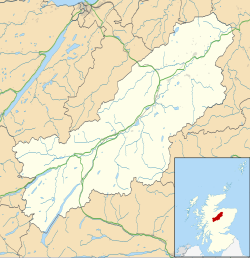Ruthven Barracks
| Ruthven Barracks | |
|---|---|
| Ruthven | |

Ruthven Barracks
|
|
|
Location within Badenoch and Strathspey
|
|
| Coordinates | 57°04′20″N 04°2′22″W / 57.07222°N 4.03944°WCoordinates: 57°04′20″N 04°2′22″W / 57.07222°N 4.03944°W |
| Type | Barracks |
| Site information | |
| Operator |
|
| Site history | |
| Built | 1229 |
| In use | 1229-1746 |
Ruthven Barracks (/ˈrɪvən/), near Ruthven in Badenoch, Scotland, are the smallest but best preserved of the four barracks built in 1719 after the 1715 Jacobite rising. Set on an old castle mound, the complex comprises two large three-storey blocks occupying two sides of the enclosure, each with two rooms per floor. The barracks and enclosing walls were built with loopholes for musket firing, and bastion towers were built at opposite corners. Destroyed by Jacobites following their retreat after the Battle of Culloden in 1746, the Barracks ruins are maintained as a Scheduled Monument by Historic Scotland. They are accessible at all times without entrance charge.
The first castle (fortified structure) was built on the hilltop site in 1229. It was used as a base by Alexander Stewart, Earl of Buchan, the younger son of King Robert II of Scotland. The first castle at Ruthven was demolished in 1451 and replaced with a second castle, completed in 1459.
The castle was contested during the Wars of the Three Kingdoms and later the John Graham, 1st Viscount Dundee attacked Ruthven castle and severely damaged it during the Jacobite rising of 1689.
Due to continued unrest, the British government decided to build fortified barracks in strategic locations: the new barracks at Ruthven were completed in 1721 on the castle hilltop. The barracks accommodated 120 troops and 28 horses for dragoons. In August 1745 a unit of 12 British soldiers, commanded by a Sergeant Terrence Molloy of the 6th Regiment of Foot, defended the barracks against 200 Jacobites and lost just one man. The following year Molloy surrendered to a larger force of Jacobites, commanded by John Gordon of Glenbuchet.
...
Wikipedia

